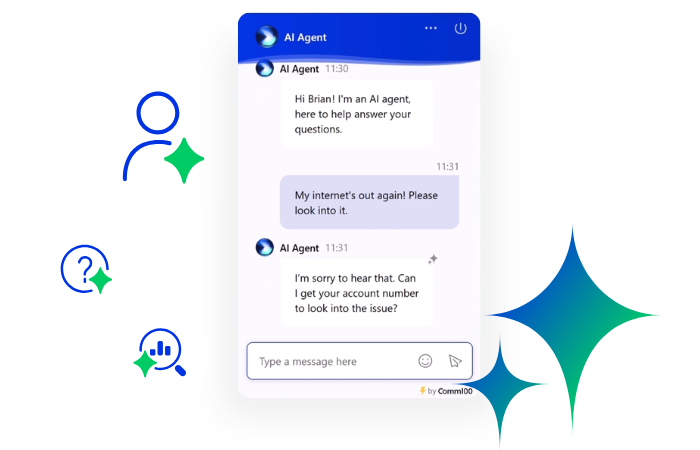As AI becomes more and more commonplace, people are
questioning “Is my job safe?”. Looking purely at the news coverage from
mainstream outlets, you’d think that we’d all be out of a job by tomorrow and
robots are taking over the professional world.
Despite these sensationalistic, click-bait headlines
swirling around the interwebs in a frenzy, this notion of AI swooping in and
taking your job is highly unlikely. Not least because AI doesn’t live in a
vacuum; it can’t go on the internet and apply for jobs on Indeed or talk your
manager into replacing you.
Seriously though, the proliferation of AI is not threatening
your job. Technology isn’t nearly advanced enough for AI to threaten to wipe
out vast swathes of the employed population.
Agent jobs are far more threatened by the idea that humans
and AI are mutually exclusive and interchangeable. While contact center roles
do offer opportunity for automation, some people assume that means we can cut
agents out of the picture. That will never be the case – even hundreds of years
in the future, AIs will never be able to provide service that’s full of wisdom,
empathy and, well, humanity.
Those that hold an agent-replacement mindset are missing out
on an opportunity to really take advantage of AI’s true benefits. The
relationship between AI and humans is symbiotic: machines need humans and
humans can reap endless benefits through automation.
What is AI?
Before we dive in too deep, it’s important to understand
what AI is, how it works, and what it does in the context of customer
experience.
Science fiction often portrays AI as robots with human-like characteristics, more often than not looking to destroy the world (thanks Terminator). Those types of autonomous, thinking AI are what’s known as General AI – technology that we are nowhere near to making a reality.
Today’s definition of AI encompasses everything from chatbots, to voice assistants like Google Duplex, and even the recommended playlist pushed to you on Spotify. These AI applications are properly known as narrow AI – meaning that they are designed to perform narrow tasks.
Examples of narrow AI used for customer experience are Chatbots, Intelligent Assistants, and Sentiment Analysis – all forms of AI that are built to perform a single function.
In the middle of narrow AI and general AI is strong AI – a single form that would be able to perform all the functions of chatbots, intelligent assistants, sentiment analysis and more. While scientists are working on creating strong AI applications in a number of fields, we’re not at the place right yet where this exists in the contact center.
A common misconception with AI is that it’ll displace humans
when that is simply not the case given that AI is currently only ideal for
narrow use cases. Because of this, a smart AI strategy is to pair AIs with
humans to take advantage of the best aspects of each.
Humans and bots, working together
One of the difficulties with the term “Artificial
Intelligence” is the assumption that AIs are smart enough to deploy themselves.
That’s not correct – AI, like any customer communication software, needs to be
set up properly otherwise it won’t work. There’s no magic button that’ll kick
it into action. Deploying AI
takes time, effort, and a comprehensive plan in order to be successful.
Even then, AI needs routine maintenance, updates, and
“tuning”. Think about agents who have just finished their onboarding – these
agents still need feedback and help to grow into agents with experience and
expertise. Just like agents in training, AI needs to be trained to provide optimal
responses too.
On the end of the spectrum, humans can certainly benefit from AI’s automation capabilities. Depending on how your knowledge management system is structured, it can take a long time and much clicking for an agent to find a specific knowledge base article, user guide, or relevant resource to help them resolve a query. Agent-facing AI cuts out this manual work by immediately suggesting the relevant resource based on the context of the customer query – solving queries quicker and freeing up agents to focus on more important work.
At Comm100, we call this Agent Assist. This AI feature monitors your live chats, understands the questions being asked, and suggests the answers from your knowledge base, canned messages and chatbot intents. Within a double-click of the mouse, your agent can choose and send the most relevant answer. That’s AI efficiency.
Cutting corners a good customer experience does not make
A successful customer experience strategy strikes a good
balance between being customer-centric but also being realistic in what your business
needs, goals, and bandwidth are. Customers want service in the channels they
prefer, whenever they want it. As a result, deploying technology does not equal
immediate user adoption.
When McDonald’s and other fast-food chains started implementing self-serve kiosks, media outlets were whipped into a frenzy, prophesizing the death of cashiers and the minimum-wage workers. Two years later and this phenomenon has still not been realized. Customers still flock to cashiers to order rather than the self-checkout for a very simple reason: They just prefer to interact with a human.
That’s not to say roles and preferences will stay static while
AI adoption continues to take off. Simply, adopting AI gives everyone more and
better choices.
- Customers get to choose from quick, consistent AI
service versus deeper human engagement when required.
- Agents get to send AI to work on monotonous, repetitive
queries, making their workload lighter and less boring.
- And organizations get to make savings or double
down on quality improvements once AI reduces agent workloads.
As this technology becomes more prolific, jobs will actually change and evolve depending on the needs of the industry. One of my coworkers was recently hired as a “Chatbot Architect”, a role that didn’t exist twenty years ago.
AI is not a replacement for agents by any means and it is
not taking jobs. If anything, it’s driving change and evolution within the
professional world. As this evolution progresses, the outdated mindset of bots
over humans will hopefully evolve as well.






